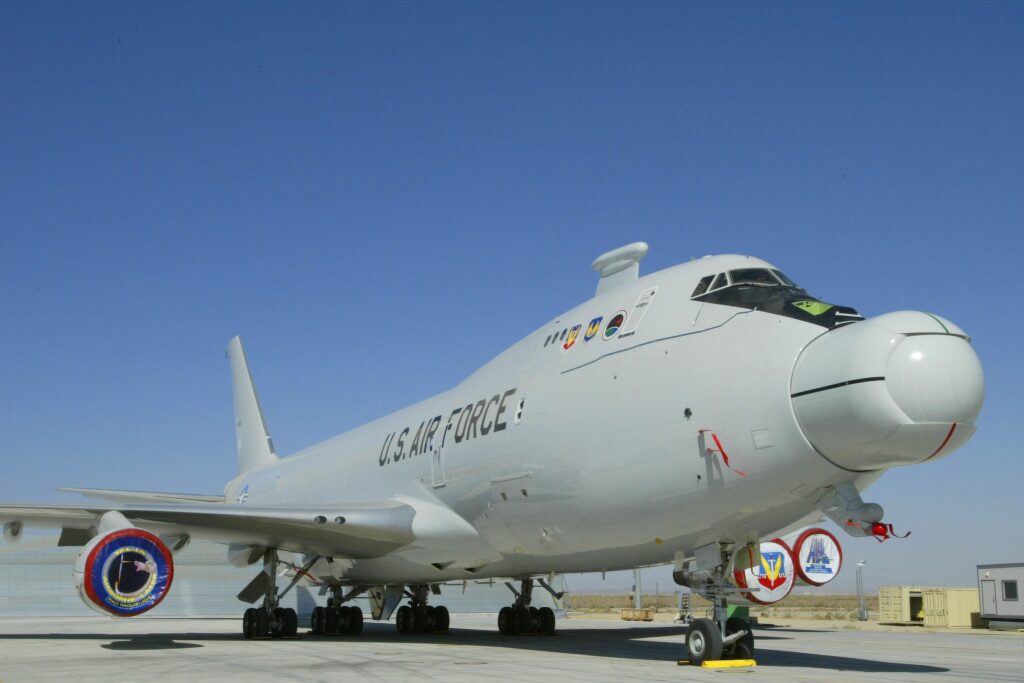
The Airborne Laser Testbed, mothballed in 2012.
HUNTSVILLE, ALA.: Three years after the Missile Defense Agency mothballed its massive Airborne Laser, MDA is planning to reboot the concept for a new era.
The old ABL was Boeing 747 with a human crew and tanks of toxic chemicals to generate power. The new idea a high-altitude, long-endurance drone armed with a more compact electrically powered laser. But the technical and tactical challenge remains the same: building a laser-armed aircraft that can shoot down ballistic missiles at their most vulnerable, just after launch, without having to fly so close it gets shot down itself.

Frank Kendall
“The problem with boost phase is…you’ve got to get close enough,” Frank Kendall, the Pentagon’s procurement chief, told reporters at the Space & Missile Defense conference here. By closing in, he said, “you get a softer target: The booster, the rocket itself, is a lot softer than the reentry vehicles.” But if you’re close enough to shoot at a rocket right after it launches from enemy territory, you’re probably close enough for the enemy to shoot you.
“I was in the Pentagon when the Airborne Laser was proposed, and I asked questions about how many we would have to buy, how we’d know to put them in the air, and how we’d keep them alive,” Kendall recalled. “We didn’t have good answers to those questions, but we went ahead with the Airborne Laser anyway.”
The Missile Defense Agency will take an “incremental, step-wise, knowledge-based” approach this time, pledged the MDA director, Vice Adm. James Syring, in remarks to the Huntsville conference. “It is a very different approach than we did in the past of just leaping to something and investing everything we had.”
MDA will conduct experiments and review alternatives until 2018-2019, when Syring said it will pick “which technologies we think have the most promise.” Then a “low-power laser demonstrator” will fly circa 2021. When the full-power system will enter service is an open question, not answered in Syring’s brief.

Vice Adm. James Syring
MDA has already used existing drones to experiment with the systems required to aim the laser. “The work that we’re doing with the General Atomics Reaper and the work that we did with the Boeing Phantom Eye starts to show it can be done, in terms of these long-range sensing and tracking capabilities that we need,” Syring said.
The Missile Defense Agency is setting itself a higher bar than other military laser efforts. The Army, Air Force, and Navy have done “great work” on laser weapons for other missions, Syring said, but shooting down missiles in the boost phase requires much greater power, range, and beam quality. In fact, it may require higher performance than even the massive Airborne Laser managed.
In a successful 2010 test, ABL shot down a ballistic missile “tens of kilometers” away, Syring said, using about a megawatt of power. For the illustrative concept of operations the MDA director briefed at the conference — which he emphasized was not the only option — “we need to be hundreds of kilometers [from the target] in a platform that can go much higher and stay up for much longer.”
The manned Airborne Laser maxed out at an altitude of about 40,000 feet, where clouds and turbulence made it harder to keep the beam on the target. “65,000 feet is where we think we need to be,” said Syring, where the air is so thin that a laser beam can reach much farther.
Even in ideal atmospheric conditions, however, the power requirements are high: “hundreds of kilowatts to megawatt-class,” Syring said. “We’re today at tens of kilowatts in the lab with the beam quality we’re after.”
What matters is not just maximum power, but how much weight it takes to generate (power density), especially when you’re trying to fit the laser on an aircraft. The Airborne Laser took 55 kilograms (about 120 pounds) to generate a kilowatt of laser power, Syring said, which is why a megawatt (1,000 kW) took a 747. Electric lasers currently in the lab take 35-40 kilograms per kilowatt, and the MDA research program plans to drive that down by a factor of ten, to 3-5 kg/kW. MDA’s ultimate goal is 2 kg/kW, which would make a one-megawatt weight 5,000 pounds, something a drone could carry.
“If it had been easy we would done it by now,” Syring said. But given the rapid progress in laser technology, he went on, “it’s not a huge reach.”
“There’s a lot of work that has go on,” the admiral continued. In the traditional “crawl, walk, run” scheme, “we’re in crawl mode at this point,” he said, “but that doesn’t mean we should stop.”
“Is such a system in the realm of the possible? Yes,” said Mark Gunzinger, a laser expert and advocate at the Center for Strategic and Budgetary Assessments. “Technology would support the development and possibly fielding of a 300 kilowatt or more solid-state laser within five years,” he told me. “Developing and integrating an SSL with a very high-altitude unmanned aircraft which would probably have to be designed from scratch would take longer, of course.”
“I think the most important point may be that MDA’s concept is not the ‘return of the ABL,'” Gunzinger went on. “MDA’s concept would take two maturing military technologies — unmanned systems and directed energy — and combine them to create a new weapon system that takes advantage of the attributes of both.”
Unlike a manned aircraft whose crew must land and rest, a drone can stay aloft for 24 hours or more. Unlike a chemically powered laser, or conventional missiles and guns for that matter, an electric laser can keep firing as long as the aircraft’s generators are running. A mid-air refueling both keeps the drone flying and “reloads” its ability to generate power for the laser. The combination of unmanned endurance and unlimited shots means a single drone could stay on station for days, instead of needing multiple manned aircraft to come and go in rotation.
What’s more, an electrical laser can dial its power up and down for different targets at different ranges. That would let the laser serve double duty, protecting the drone carrying it against enemy fighters and anti-aircraft missiles, Gunzinger said. It might even shoot down enemy aircraft at a distance, without having to wait to be attacked.
“Thinking of this as a ballistic missile killer may be too narrow,” Gunzinger said. If MDA can actually solve the boost-phase intercept problem, hard as that is, it will have built a laser-armed aircraft that’s lethally adaptable to other missions as well.
Lockheed Martin projects potential $1 billion loss on classified program
Lockheed CFO Jay Malave said the company currently expects the program to become profitable on an annual basis around the 2028 timeframe.


























